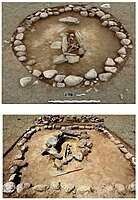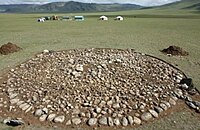Sagsai culture
Appearance
 Sagsai culture sites in Western Mongolia | |
| Geographical range | Mongolia |
|---|---|
| Period | Bronze Age |
| Dates | 1500 BCE — 1000 BCE |
| Major sites | Minusinsk Basin |
| Preceded by | Afanasievo culture Chemurchek culture Munkhkhairkhan culture |
| Followed by | Deer stones culture Pazyryk culture Chandman culture |

The Sagsai culture (1500-1000 BCE) is an early Bronze Age culture of Western Mongolia. It was centered on the Sagsai area (the westernmost region of modern Mongolia) and succeeded the Chemurchek culture.[2]
The Sagsai culture is thought to have used horse chariots, prior to 1200 BCE, as shown by dated petroglyphs in the region. It was followed by the Deer stones culture.[3]
At the same time the Ulaanzuukh-Tevsh culture was prospering in the steppes of southern and eastern Mongolia in the 13th century BCE, and seems to have transmitted the horsedrawn chariot to the Chinese Shang dynasty.[4]
-
Sagsai-shaped graves, Mongolia.
-
Sagsai-shaped graves, Mongolia.
-
Sagsai-shaped graves, Tsagaan Asga site (round).
-
Sagsai-shaped graves, Tsagaan Asga site (square).
References
[edit]- ^ Gantulga, Jamiyan-Ombo (21 November 2020). "Ties between steppe and peninsula: Comparative perspective of the Bronze and Early Iron Ages of Мongolia and Кorea". Proceedings of the Mongolian Academy of Sciences: 65–88. doi:10.5564/pmas.v60i4.1507. ISSN 2312-2994.
- ^ Ventresca Miller, Alicia R.; Wilkin, Shevan; Hendy, Jessica; Turbat, Tsagaan; Batsukh, Dunburee; Bayarkhuu, Noost; Giscard, Pierre-Henri; Bemmann, Jan; Bayarsaikhan, Jamsranjav; Miller, Bryan K.; Clark, Julia; Roberts, Patrick; Boivin, Nicole (11 May 2022). "The spread of herds and horses into the Altai: How livestock and dairying drove social complexity in Mongolia". PLOS ONE. 17 (5). doi:10.1371/journal.pone.0265775. hdl:10072/428871.
- ^ Esin 2021, p. 1, Systematic analysis of rock art styles and burial traditions based on radiocarbon dates of burials and ritual deposits of bone enabled us to distinguish two periods of chariots’ usage here: 1)prior to ca. 1200 BCE, in the Sagsai culture; 2) after ca. 1200 BCE, with the DSK culture. (...) Our research suggests two primary periods for the use of chariots, prior to ca. 1200 BCE, in the Sagsai culture – the first period of the late Bronze Age (LBA-1)..
- ^ Esin 2021, p. 11, In a broader historical and geographical context, the first period coincides with the chariot distribution all over the eastern part of the steppe zone, and with its appearance in the graves of aristocracy of the Shang state in the end of the 13th century BCE – there is unquestionable evidence for Wu Ding’s reign, ca. 1250–1192 BCE (Shaughnessy, 1988; Wu, 2013; Shelach-Lavi, 2014: 15). At the same time, their appearance just near the Shang’s borders is apparently connected with another cultural group of the late Bronze Age: the Ulaanzuukh-Tevsh that existed in the 13th century BCE in the steppes of eastern and southern Mongolia, as well as and Inner Mongolia (Rawson et al., 2020)..
Sources
[edit]- Esin, Yury (1 September 2021). "Chariots in the Bronze Age of Central Mongolia based on the materials from the Khoid Tamir river valley". Archaeological Research in Asia. 27: 100304. doi:10.1016/j.ara.2021.100304. ISSN 2352-2267.




